For half a century, the Tech Center in Mossville has been the hub of Caterpillar’s R&D efforts.
The Tech Center is the home of Caterpillar’s Product Development and Global Technology Division, which also owns the proving grounds in Peoria and Tucson, design centers in India, and R&D centers in the U.K. and China. When it opened in the early 1960s, the company spent $38.4 million a year on research and development; today, that figure is more than $2 billion. Around 2,000 people—highly-trained scientists, engineers, technologists and experimental mechanics—work in seven buildings across 900,000 square feet on a campus that runs 24 hours a day, seven days a week, 365 days a year.
Employees at the Tech Center are currently engaged in the largest product development effort in Caterpillar history: to design, test and deliver products that meet the emissions standards set by the U.S. Environmental Protection Agency (known as “Tier 4”), as well as the latest regulations from Europe and Japan. More than 300 existing products are being redesigned over the course of the six- to eight-year effort, with emissions reduced to near-zero levels. The technical challenges of meeting these requirements—without sacrificing power or performance—are among the projects tackled here in Mossville. On an unseasonably warm day in April, I toured the campus. Here’s what I saw.
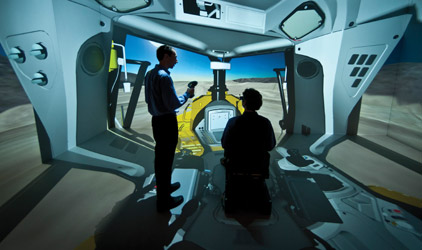 Inside the Cave
Inside the Cave
Our first stop was Building F, home of engine research and the Immersive Visualization Center, where I met Galen Faidley, team leader in Virtual Product Development. Here, in what is believed to be the largest virtual reality “cave” in North America, an immersive 3D environment allows products to be simulated and tested before they are even built. Issues of assembly, service, operator visibility and ergonomics can be identified early on to ensure that every aspect of the design is optimal. The same applies to manufacturing processes: engineers can virtually “walk through” an assembly line as it’s being designed, allowing them to identify potential problems before putting together a real-world production line—a very expensive process. Faidley, research engineer Abhishek Seth, Sr. and a team of regional experts are working to deploy the technology across Caterpillar.
Anything that can be modeled by a computer and tested before “going to iron” reduces costs and time to market, so it’s easy to see why Cat has moved heavily into the virtual space. “The earlier that issues can be discovered, the easier and cheaper it is to fix them and make adjustments,” explains Faidley. “It’s an order of magnitude at every step. So if an issue costs $1 to fix in the conceptual stage, it will cost $1,000 to fix in production. In addition, your ability to optimize decreases over time as you start to lock things in.”
Operator visibility is among the primary applications for the virtual space; what you see in the cave is exactly what you’d see from the cab of a real tractor. It’s also ideal for service and assembly audits. “You can interact with virtual components, assemble and disassemble parts…so we can make sure we have the sequence right and verify that there are no ergonomic issues.”
Design reviews can also be conducted virtually. Here, each of the teams that helped design the machine—from hydraulics to electronics—can “kick the tires on it,” he says. “It’s the first time that everything is all together, in life size, as one machine. It’s amazing what we discover by bringing those teams together.”
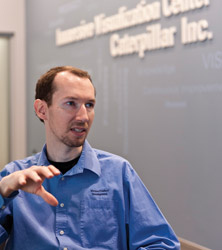 Faidley hands me a pair of 3D glasses—similar to what you’d get at the movies—and soon I was standing next to a simulated D7E track-type tractor. I felt like I had to climb up onto the large machine to get into the cab, even though in the physical world, I was really just sitting down in a chair. Looking out from the cab onto a worksite, it felt like the real thing. A network of computers tracks both the chair and the glasses, so it always knows the position of the operator in relation to the virtual machine. Parameters can be changed very quickly—at the push of a button, I was in a D7R.
Faidley hands me a pair of 3D glasses—similar to what you’d get at the movies—and soon I was standing next to a simulated D7E track-type tractor. I felt like I had to climb up onto the large machine to get into the cab, even though in the physical world, I was really just sitting down in a chair. Looking out from the cab onto a worksite, it felt like the real thing. A network of computers tracks both the chair and the glasses, so it always knows the position of the operator in relation to the virtual machine. Parameters can be changed very quickly—at the push of a button, I was in a D7R.
Next, Faidley put a tracking device on my hand and instructed me to come out of the cab and walk around the machine. But looking down, my body didn’t want to take that step; though my feet were firmly planted on the ground, it seemed like stepping off a cliff. I eventually made it down, and using the tracking device, I could point at the different components and move them around to see the inner workings of the engine. “You can walk around them, duck underneath them—even put your head in the engine if you want,” he offered.
Immersive visualization, says Faidley, is where man meets machine. While the current simulated environment is mostly visual, as the technology progresses, so will the sensory experience. “We can simulate how the engine will perform,” he says, “but some things are subjective and very hard to model. We’re not yet at the point where we can simulate how a human being will interact with the machine…but we’re working on it!”
20/20 Vision: The North Star
Leaving behind the virtual world, I was introduced to Lou Balmer-Millar, director of research and advanced engineering. With a PhD in materials science and experience at the Pacific Northwest National Laboratory, Balmer-Millar was recruited for her extensive background in emissions. She is charged with executing Caterpillar’s enterprise technology strategy—the “North Star,” as she calls it, that guides the company’s R&D efforts.
“We look at global trends and how they might affect customer needs in the future,” she explains. “Where is the world going? What’s the customer going to need in 2020? We need to make sure we have alignment within the company, so the things we’re doing here in Research make it into those components and products at the right time…which is trickier than it sounds, because of the breadth of our product line.”
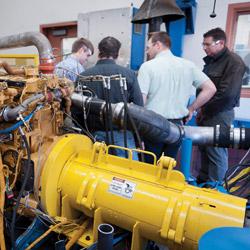 So how do you get to near-zero emissions? It starts with the high-tech molecular modeling done right here in Research. Everything works together, hand in hand. Meeting those Tier-4 regulations means improving fuel efficiency, which also lowers the customer’s operating costs, in addition to reducing greenhouse gas emissions.
So how do you get to near-zero emissions? It starts with the high-tech molecular modeling done right here in Research. Everything works together, hand in hand. Meeting those Tier-4 regulations means improving fuel efficiency, which also lowers the customer’s operating costs, in addition to reducing greenhouse gas emissions.
Caterpillar’s R&D efforts fall under three general areas: energy/power systems, machine/machine systems, and automation/enterprise solutions. Under the first, the company is working to improve the power density of its engines; examining alternative fuels such as liquefied natural gas; and testing a variety of ways to reduce the cost of engines while improving their efficiency. In the area of machine systems, the company continues to work on improving performance and lowering production costs: new materials and manufacturing techniques, advancements in hydraulics, and improved efficiencies in areas such as blade performance are among these initiatives.
Automation is a leading area of research: remote-control operations are here already, while machine autonomy is not far off. “We’ve got customers in Australia, for example, with mining sites in the middle of nowhere,” says Balmer-Millar. “They have to fly in their people, the water and the living quarters, and it’s very expensive—in addition to the safety concerns. But if the operator can be back in Sydney in front of a screen, operating remotely…that’s where we’re heading.
“And the next level beyond that is autonomy,” she continues. “That is, you don’t even have someone back in the office; you are actually hauling autonomously.” This comprises a sizeable portion of the company’s current research—“all the things that go into making an autonomous vehicle safe and efficient for our customers.” It sounds like science fiction, but the company has already seen experimental success in this area.
In its quest to develop autonomous vehicles, Caterpillar has partnered with Carnegie-Mellon University, one of many outside partnerships. The company shares technology with NASA, among other agencies, universities and laboratories, and supports a number of robotics competitions for kids, geared to spur interest in math and science and build the pipeline of future engineers. In each of these initiatives, the capacity for high-performance computing is a constant—all that data being generated 24/7 is useless if it can’t be transformed into actionable intelligence. And life on the cutting edge makes for an exciting place to work. “That’s the great thing about being a researcher here,” says Balmer-Millar.
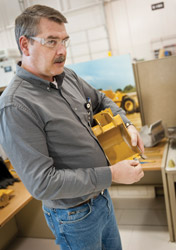 Where Machine Meets Earth
Where Machine Meets Earth
Donning our safety glasses, the next stop was the Earth Mechanics lab, where I met senior technologist Tom Congdon. “Our focus in this facility is the interaction between the machine and the earth, whether it’s with the implement—the blade or the bucket—or the tires and tracks,” he says. “We do that by trying to get a firm understanding of the physical behaviors of earthen materials—whether soil, rock or mud.”
Three long bins—the largest more than 90 feet long—stretch across the room, each filled with different kinds of soil. An assortment of blades and other implements, each slightly different from the next, rest on tables nearby. Here, Congdon performs scale-model testing of blades, tips and other components, always seeking to maximize performance for the customer.
One bin is used primarily for evaluating mobility—the track, the tires, the wheels. Another evaluates loadability—the ability to efficiently load a bucket. The third is used to test blades and tips, where slight changes can mean huge increases in performance. “By understanding the interaction between the machine and the soil that you intend to dig in,” he notes, “we can optimize the shape of the implement for that specific condition.” A fourth, smaller test rig is designed specifically for evaluating a vehicle’s performance as it dumps its payload.
For today’s demonstration, a 1/9-scale bulldozer blade is mounted over the third bin. “Here, we’re monitoring the forces acting on the blade,” Congdon explains. “How much traction have we got? How much velocity? What is the optimal position of the blade…to ensure it is moving through the soil properly within the constraints of the machine?”
It might look like just a bunch of dirt, but there are very specific recipes for making this soil and a slew of scientific formulas for recreating precise, real-world conditions. Congdon sends the blade skimming through the soil, a demonstration that lasts all of 10 seconds, but represents 30 seconds in real life according to the formula. In those 10 seconds, a wealth of data has been recorded. That data will be analyzed and sent back to the business unit, which will determine how to make the design manufacturable and cost-effective.
“I’m often told, ‘Well, you’ve been making bulldozers for 85 years, don’t you know how to make a blade yet?’” Congdon chuckles, explaining that it’s not as simple as it looks. The physics might be the same as when the first Caterpillar tractors rolled off the assembly line a century ago, but new technologies have enabled them to study things they couldn’t in the past. Meanwhile, “our machines keep changing,” says Congdon. “The blade is not just a piece of iron; it’s matched with the tractor’s capability. So as our tractors change, our blades have to change, too. And this is a very low-cost way of validating those changes.” 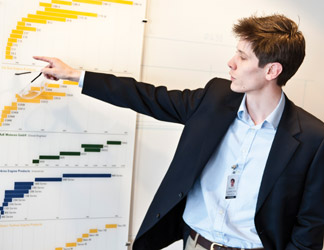 Engines in Iron
Engines in Iron
From the relatively small Earth Mechanics lab, we headed to the enormous Global Engine Development facility, where Matt Larkins, operations manager, oversees 106 test cells that monitor and assess Caterpillar engines ranging from 100 horsepower all the way up to 9,000 horsepower. With engines in various stages of testing down every corridor, this is not a place for peace and quiet.
Having been modeled extensively in the virtual world, the engines and other components are now “in iron”—tangible, physical objects. “We’re effectively validating the product for our product groups,” says Larkins. “They hand the engine over to us to try to break it, essentially—to make it more reliable and durable. But the bulk of the work we do here is emissions testing.”
A typical installation involves two test cells, with a control room between them. An engine rests on a bed in each cell, hooked up to a dynamometer that turns it over to simulate its performance. In the control room are all of the myriad pieces of instrumentation involved in collecting the reams of data being continuously generated. “We measure as much data as we can,” he explains, “so we can get the most benefit out of every engine.”
A green light outside the cell means a test is currently underway; a door painted yellow means the engine inside is being officially certified. Beneath the floor, the basement holds all of the materials needed to run the tests—fuel, water, chemicals and the like.
Each test cell measures a different aspect of the engine or component. Some simulate performance at a variety of altitudes; others, known as anechoic chambers, measure the noise an engine makes. In the cold chambers, the temperature is lowered to minus 50 degrees Centigrade to test that the engine functions properly under extreme conditions. “We need to prove that the product works in many different environments,” says Larkins, “both hot and cold.”
In a nearby cell, he explains that a deterioration factor test is being run to predict the engine’s emission performance over its useful life, as required by regulations. “This test will run for just under 3,000 hours and burn about 50,000 gallons of fuel,” he says. “The engine will be on the bed for about three months, and we will measure the emissions periodically throughout that cycle.”
Finally, Larkins leads us to the Obeya room (Japanese for “big room”), the operations center for the entire facility. Derived from Japanese quality initiatives, the Obeya concept is to collect everything needed to run operations in a single room. Here, each cell can be monitored in real time, while a host of metrics can be tracked. With live data constantly streaming in, any issues that arise can be handled quickly and effectively. All in all, the engine lab is a stunning display of Caterpillar’s enormous capital investment in its equipment and facilities.
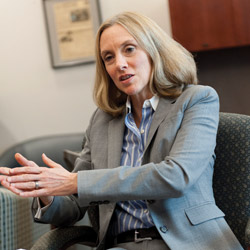 Elevating the State of the Art
Elevating the State of the Art
We wrapped up the tour in the office of Tana Utley, chief technology officer and vice president of the Product Development & Global Technology Division. She oversees about 10,000 engineers and technologists spread out across the world. “Our role in this division,” she says, “is to be the ‘glue.’” With her engineering background, Utley has a firm grasp on the underlying technologies and work being done under her purview. She asks my impressions of the tour so far, and waxes poetic on Newton, physics, computer simulation and the quality of her workforce.
“Think of the luxury to have someone with the expertise of a Tom Congdon, who’s spent his whole career studying dirt. And in the same building, you talked to Lou [Balmer-Millar]… Some of her people are working on that next generation of high-performance supercomputing. We’re partnering with the Oak Ridge National Lab, Pacific Northwest, Argonne National Lab…to have all of that…and the people inside the company who can tap into that network to advance the science and the state of the art—that is a real luxury we have.”
She pauses. “That phrase, ‘state of the art,’ is something people take for granted,” she says. “In many instances, we are defining the ‘state of the art’ here. That’s what you saw in the Visualization Lab—the largest in North America. We are defining the standard…by which everyone will measure themselves.”
Like all the people I met along the way, she never fails to turn the conversation back to the customer. “To use these sophisticated kinds of ‘toys,’ there has to be a business purpose. We try to emphasize the importance of understanding the customer and how they use those machines to make money… Our customers will look at a Cat and a Deere, and they’ll ask the dealer, how will I make more money using this than if I bought the Deere? And that goes all the way back to Tom Congdon understanding how that blade moves through the dirt.”
She admits to getting a little nervous before meeting with a customer—“not because I’m shy or afraid. It’s that I know how much work we put into it.”
“Our customers give us our report card,” she affirms. “It’s like when you’re a kid—that’s how I feel when I meet with a customer… We’ve brought our market share up steadily over the last few years as we’ve really focused on understanding customer needs and getting the basics right—quality, delivery and service.”
One of her objectives is to expand Caterpillar’s reputation for product development and its visibility within the global engineering community—“to elevate the state of the art and encode it, so it becomes the way we do business, and to leave a legacy of excellence,” says Utley. “These engineers who’ve been through the Tier 4 product development journey—they really know how to develop product. That’s where our real competitive advantage is.
“The only sustainable competitive advantage any company can have,” she adds, “is through its people and the organization’s ability to continuously improve and learn from the past, to become more innovative and productive. That’s really what we’ve been working on: creating that legacy.” Seen up close, it’s a legacy that‘s even more impressive. It’s shaping the world we live in, and it’s being created right here in central Illinois. iBi


